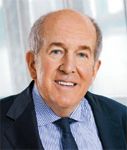The Human Chain: The Emerging Pharma Leaders
Pharmaceutical Executive
Amid the release of our eighth list of Emerging Pharma Leaders, it's fitting to take a look at the trends and values that will determine true leadership in big Pharma in the years ahead.
PHARM EXEC'S 2015 ROSTER OF EMERGING LEADERS-our eighth to date-is not only a way to recognize a few individuals who’ve made a difference in their organizations. It also serves as a barometer to track larger changes in the workplace: how work is done; who does it; and for what outcome or purpose. With
William Looney

the support of Pharm Exec’s Editorial Advisory Board (EAB), we’ve selected 17 executives drawn from a range of mission-critical functions, varied geographies, and diverse race, gender, and cultural characteristics. Together, they symbolize the sweeping changes our industry is undergoing, from an era where growth was the assumed baseline for all management decisions to a future of iffy margins and bitterly contested market share.
This year’s group knows better than anyone that a frayed business model quickly concentrates the mind. So what are the trends and values that will determine true leadership in big Pharma for the remainder of the decade? We’ve distilled five of the more interesting insights, as follows:
It’s all about the team. Teams are reflective of how work gets done in large organizations facing complex challenges that rarely can be addressed with a single set of capabilities. Team performance is critical to organization P&L because it is the team that creates the context and sets the baseline for decisions taken by senior management. The team is also the arena for individual career advancement. No one mentions it, but team meetings can also be a graveyard for reputation. In big Pharma bureaucracies, what was once the right way and the wrong way is now the way of the multiple choice. It’s easy to stray, so a deft hand in internal politics has become a necessary navigational skill.
Leadership-it’s never about you. Leadership today is a collective exercise, amounting-almost-to an abnegation of the self. Our 17 EPLs are parsimonious in using that first person pronoun. The emphasis is on other-directed qualities like empathy and listening. It should be no surprise when leaders discover what their team members actually feel about them. In contrast to the command and control methods of a previous era, our 2015 leaders are more willing to let others carry the flag to ensure everyone is invested in a positive result. As one EPL notes, “if I can take credit for anything, it’s that I hired well.”
The key emotional chord in today’s pharma workplace is to convey a sense of urgency. The role of a leader must not be confused with handing out trophies at the country club. A balance has to be struck. But that urgency has to be laced with a larger sense of purpose. Our EPLs call it “hard empathy”-being tough-minded on standards but tender-hearted and hopeful in relationships. The essential mediating ingredient is decisiveness. It’s still true that pharma leaders don’t progress by going wobbly. “Analysis paralysis” remains a curse in any organization.
The best innovations are often a consequence of a workplace failure. A repeated theme in the interviews is that good organizations impose no sanctions on failure. Making mistakes is “part of the job,” and what counts is a willingness to turn a setback into a “best practice” that can be shared with others as a mid-course corrective. Management will need that approach to navigate through changes that are becoming harder to account for in advance.
Culture counts-but make it simple. Raptor’s rare disease CEO Julie Smith said it best in making reference to her ever-present canine companion, Ninja: “Dogs are an important part of the culture here.”
Enough said.
Finally, our annual Emerging Leader profile is complemented by a separate feature this month-a Roundtable on the themes of talent and diversity in tomorrow’s biopharma workforce. Executives from two big Pharma companies, a start-up biotech, a leading Pennsylvania-based hospital system, and an HR diversity specialist met at St. Joseph’s University Business School on April 10 to consider what’s needed to ensure our industry has the people to stay profitable in a fast-changing marketplace.
One interesting dynamic emerging from the discussion is the competition traditional pharma faces from an invigorated biotech sector flush with the momentum of a hundred IPOs. Nimble biotech has the hands on business model-and the cash-to vie for big Pharma professionals disgruntled by a seemingly endless cycle of restructuring and consolidation. A second point of consensus is that workforce diversity must be given higher priority internally, as a business imperative instead of an HR objective. And what we mean by “diversity” must stretch beyond the obvious aspects of gender, race, and ethnicity to incorporate true diversity of thought-because, regardless of where it comes from, the single biggest premium for our industry is a good idea.
William Looney
is Editor-in-Chief of
Pharm Exec
. He can be reached at
wlooney@advanstar.com
. Follow Bill on Twitter:
@BillPharmExec
Cell and Gene Therapy Check-in 2024
January 18th 2024Fran Gregory, VP of Emerging Therapies, Cardinal Health discusses her career, how both CAR-T therapies and personalization have been gaining momentum and what kind of progress we expect to see from them, some of the biggest hurdles facing their section of the industry, the importance of patient advocacy and so much more.
Applying Porter’s Five Forces to Portfolio Management in Pharmaceutical R&D: A Strategic Roadmap
March 17th 2025The increasing costs and complexity of R&D in the pharmaceutical industry have necessitated the adoption of strategic portfolio management to optimize resource allocation and enhance competitive advantage.
